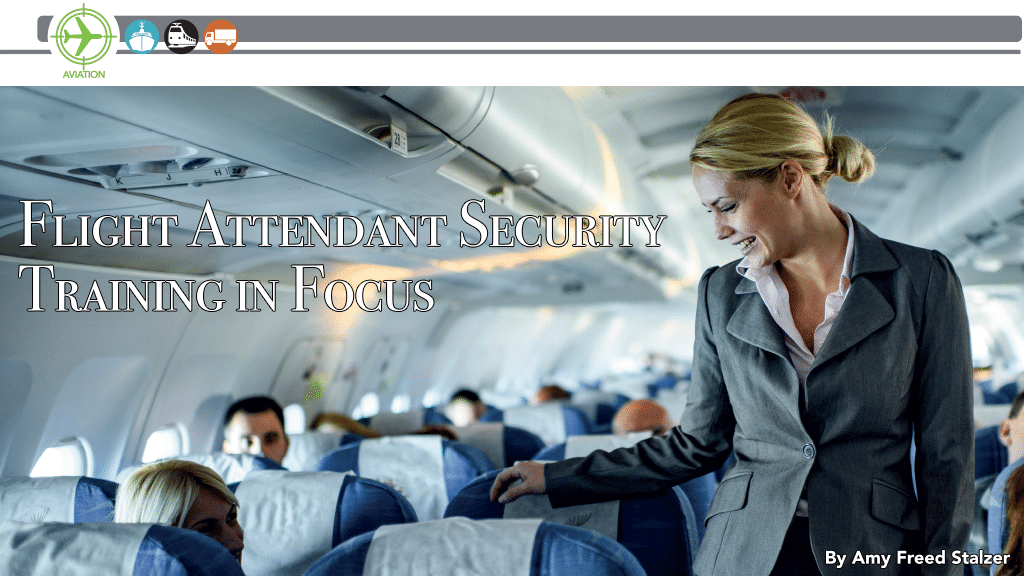As the role of the commercial flight attendant grows ever more important in ensuring the protection of passengers, both in-person and emerging technologies will play a role in their training.
Last year was the second most disruptive with regards to unruly U.S. airline passengers since the FAA started tracking data in the mid-1990s, with 2,456 unruly passenger reports and 831 investigations initiated in 2022. These totals are second only to the year that preceded it, which saw the all-time high of 1,099 investigations initiated during 2021 at the height of the pandemic.

of self defense training below.
Airline flight attendants have often borne the brunt of such bad behavior by passengers, which can include both verbal and physical abuse. Although the number of unruly passenger incidents dropped and leveled off following the end of the U.S. mask mandate on May 3, 2022, staying at or under the weekly average of 2.4 incidents per week for the remainder of that year, violent incidents by passengers have still been frequent enough to cause continuing concern among flight crews and the flying public.
Currently, commercial flight attendants can access in-person training from regulatory agencies, their employers and training vendors to learn how to protect themselves and passengers during these kinds of disruptive events. However, emerging technologies such as virtual reality and the metaverse are also expected to provide exciting new opportunities for learning and skill-building in the future, by making training more engaging and accessible for airline cabin crew members, as well as other airport employees, than ever before.
Existing Security Training Options
According to the Association of Flight Attendants-CWA, AFL-CIO, the ability of flight attendants to de-escalate and handle unruly passengers has been crucial to ensuring the protection of passengers and the crew members themselves. The AFA strongly encourages flight attendants to participate in the U.S. Transportation Security Administration (TSA) Crew Member Self Defense (CMSD) Training program, a four-hour performance-based training program tailored to airline crew members with little or no experience in self-defense techniques.
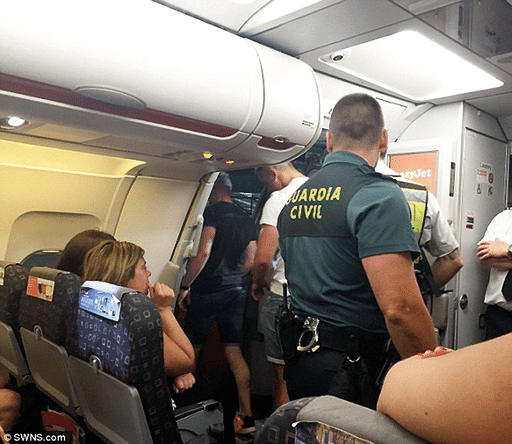
Attended voluntarily on the crew member’s own time, the program teaches the basic fundamentals of self-defense, which include stance and movement techniques, target areas of the body, personal and field-expedient weapons that might be utilized during an encounter, power-generating techniques, and mindset, i.e., mental preparation for a confrontation. The training also includes various upper and lower body strikes, how to protect against strikes being thrown by using blocks and cover techniques, and how to defend against any hand-held weapons that could be brought aboard an aircraft.
“Participants are not expected to master these techniques in this short period of time, but instead provide themselves with the mindset and self-confidence to deal with an unexpected situation,” said Max Weitzner, a spokesperson for the TSA.
The TSA is always looking to update techniques and procedures for its CMSD training program, and the agency also has worked to make this training more accessible to the crew member community by locating training sites near major airports, according to Weitzner. “From the four locations where CMSD training was initially launched, the program has expanded to include 19 sites nationwide. Since TSA launched the CMSD training program in 2004, over 26,000 crew members have received this training,” he said.
“In the last few years, many airlines have requested the TSA CMSD training program for their new hire candidates at their training facilities. To date, we have multiple airlines that have instituted the TSA CMSD training program into their initial training,” he said. “Through classes like these, we are able to share our skills and experience with our aviation counterparts. This partnership and what we are teaching today strengthens the overall transportation security posture.”
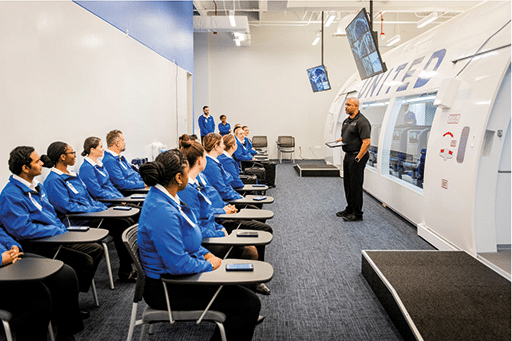
Aside from TSA training options, airlines can also provide their own customized training on how flight attendants should address incidents with disruptive passengers, and these courses have traditionally been conducted in person. For example, Delta Air Lines provides a rigorous six-week program incorporating both classroom and hands-on training, which addresses not only unruly passengers but anything that can happen during flight, including turbulence, medical emergencies and emergency landings.
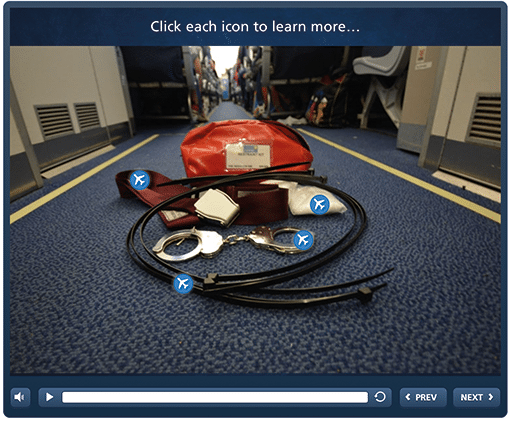
Additionally, airline training schools such as Canada-based Inflight Institute offer virtual course options to ensure that flight attendant training is available to workers worldwide, regardless of where they live or might travel.
“Cabin crew traditionally are very authentic and helpful people, but there are stress levels with that job, and not only the normal day-to-day ones, but also all number of things that can affect the performance of the crew,” said Inflight Institute president, Ivan Noel.
“Our training gives flight attendants the tools in their toolbox to have empathy and understanding,” he said. “They have a job to do, and if they have tools to do that, it’s impactful for the entire journey of the passenger. Whatever they can do to reduce stress points throughout the journey will help in the reduction of onboard incidences of disruption.”
Noel believes that one of the most important outcomes of training is ensuring the health and well-being of the crew. “That’s where our next greatest focus is, because then we can make sure that everybody’s on the same page, everyone is operating at their highest efficiency. And that well-being of the crew makes a fundamental difference in aviation security, as well,” he said.
Realistic, Interactive Virtual Training
The advent of the COVID-19 pandemic was perhaps an ideal time for companies across industries to shift and invest in virtual training as a way to keep employee skills sharp during a period of extended downtime. Unfortunately, training programs were one of the first things to go when the virus hit, with many organizations cutting training budgets in the face of layoffs and other industry disruptions.
Nevertheless, the pandemic was still a time of innovation for many companies working to bring training improvements to the aviation industry, according to Grigorii Rodionov, co-founder and CEO of Netherlands-based AVIAR.
AVIAR bills itself as the world’s first virtual reality (VR) platform for the training of air transportation industry specialists. The company was founded on the belief that VR would provide an opportunity to create new and innovative training simulations for roles in aviation — such as flight attendants — that didn’t already have access to traditional flight simulator training like pilots did, Rodionov said.
After demonstrating a proof of concept at an IATA meeting in 2018 to a positive industry reception, AVIAR first began to develop virtual reality products for aviation professionals in two main areas, airline cabin crew training and ground operations training, with plans to also add airport and airline security training, pilot training and MRO training.
Rodionov suggests that VR software has the ability to serve as an effective and accessible resource for airlines and other aviation companies based anywhere in the world to use for both training support and internal certification. The company currently is developing customized solutions for several clients and working in a “mutual effort” with them to pursue regulatory certifications from EASA, he said.
“Airlines can use this virtual reality software as an additional training tool to increase the knowledge retention of flight attendants and reduce the number of fails during the certification process in specialized training centers. You’ll have better prepared trainees before the real exam,” he said.
Virtual reality training software like AVIAR’s differs in a few ways from the traditional video-based offerings available to professionals. The AVIAR platform offers a fully immersive, hyper-realistic, interactive training experience that places the user directly into the story and gives them agency, so they are making real-time decisions that immediately impact the direction and outcome of the narrative. Users wear VR headsets and gear that helps put them into the mindset of the story and engage with it as a character in the story.
“It’s an absolutely different type of media. You’re not an observer, or a spectator; you’re the person who lives in this situation or scenario. You’re the active person,” Rodionov said.
“The closer the simulation is to the real-life experience, the better the training process,” he continued. “We pay a lot of attention to such details, putting a lot of effort into realistic graphics and realistic interactions. But it’s not just about lifelike visuals, it’s about everything, including how the equipment responds. About how, if you do something wrong, what could happen next, what you will see next, and how you will feel.”
In support of its marketing to younger aviation professionals, AVIAR recently released a consumer version of its professional VR training software on the online gaming platform Steam. Rodionov described the gamification of industry outreach as being essential to future efforts in recruiting the next generation of aviation talent to the industry.
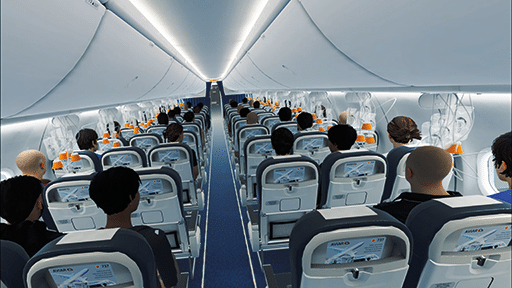
“We have to deal with a different generation of people who really perceive things in a different way,” he said. “By offering VR scenarios, we can let young people try out different roles and understand what it’s all about. It’s very important to engage them emotionally as early as possible and give them a better understanding of the environment in which they’ll be working.”
Metaverse Bringing Deeper Immersion
As the world continues to recover from the pandemic, commercial flying is at the center of the transformation of travel, and companies worldwide are investing in the digitization of their products and services as never before. Following this trend, some airlines are exploring the use of the much-hyped metaverse to train their cabin crew and other staff members.
For example, Dubai-based Emirates last October announced that it plans to train thousands of new cabin crew in the metaverse in a shift away from in-person classroom training.
While separate from existing virtual reality technology, the metaverse is a still-nascent platform that comprises both VR and augmented reality (AR) technology to fuse together real and virtual worlds, offering deeper immersion than what VR alone can provide.
The reason the metaverse is so appealing as a digital experience and training platform right now is because airline customers and workers have new expectations when they travel, said Kuruvilla Mathew, metaverse expert and chief innovation architect at UST, a digital transformation solutions provider.
“The world has definitely changed in the past two years,” said Mathew. “How do we provide a good digital ecosystem that supports the employees and gives the customers better service at the end of the day? We are looking for the travel experience to be as seamless and frictionless as possible, which puts a lot of stress on agents in the airport, airport staff, ground crews, airline crews — all of them have to do their job, which is now transformed.”
Since 2021, UST has partnered with a major U.S. airline to develop immersive digital experiences in the metaverse with the goal of improving the quality of the airline’s training and travel experiences.
In the UST-airline metaverse scenarios under development, trainees can access the experience from anywhere via different devices, including desktop, mobile and headset, but Mathew notes that the device used to access the metaverse is less important to the experience than the immersion.
“Immersion is the ability for you to get engaged in content that is so compelling, that you are drawn into the story and you are actually in the story. When you get immersed at that level, the ability for you to connect with things is huge,” he said.
“From a training perspective, you’re presented with scenarios that could be from first-, second-, or third-person perspectives, but you’re making all the choices. You’re immersed in a scenario, and you’re being presented with some sort of dilemma and you have to address it. It takes you down one path versus another and the story evolves. It’s your engagement that customizes the training experience based on the choices you make,” he said.
Mathew notes that when building metaverse training modules for any company, regardless of industry, designers ideally should begin their work with the organization’s standard operating procedures (SOPs). Those building the metaverse first need to identify what are the company’s processes for being in compliance and other requirements, in order to effectively visualize and build out specific scenarios that will fuel the digital experiences.
“Whenever you are in an immersive experience, it is very visceral,” he explained. “It connects you to that world. You can see the kinds of problems that are around you, and then you can connect the dots. And then you say that, okay, these are solutions that we can solve for.”
When UST first started on this airline project, its team went to the airport to study and understand the issues to be addressed in the metaverse context. From there, “we created a technical specification. We created graphic novels and a diorama that tells the human side of the story. When you tell the human side of the story, then what you build for is more fine-tuned and accurate,” Mathew said.
UST uses an empathy-first design approach to ensure that its digital experiences are relevant, powerful and memorable for trainees who need to retain important information and lessons learned. “One of the things that we are looking at in building this is going with an empathy-first approach, meaning let’s understand what people go through in these scenarios. Let’s not build a digital solution that doesn’t connect with people or doesn’t solve a problem,” Mathew said.
“UST always has been looking at what can we do for people,” he said. “How can we transform their experience? How can we make their lives better? That comes with empathy-first design, and really focusing on empathy and not just on usability and building a beautiful-looking user interface. Instead, let’s build a solution that’s going to help transform their lives.”
